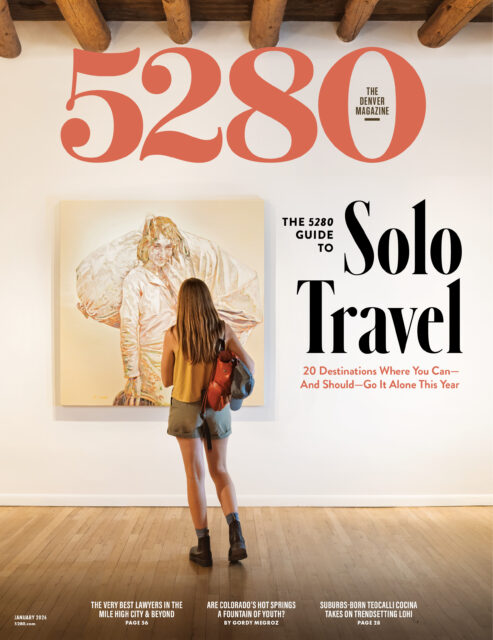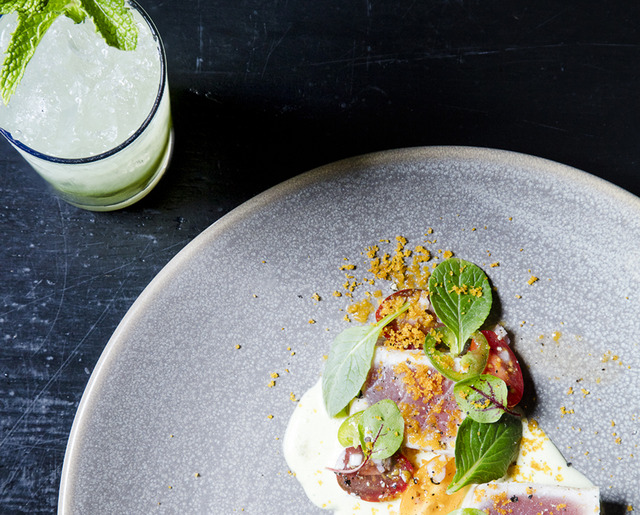The Local newsletter is your free, daily guide to life in Colorado. For locals, by locals.
Black Eye Coffee Cap Hill
2 Stars
THE DRAW: Handsome space, all-day service, very good brunch.
THE DRAWBACK: Too-complicated cocktails, hit-or-miss-service, weaker p.m. food.

Bar Fausto
2.5 Stars
THE DRAW: Expert cocktail innovation and a food menu that goes beyond bar snacks.
THE DRAWBACK: Loud unless you sit at the bar. Food not up to the quality of the drinks.
Learn more about our rating system here.
The hot craze for intricately crafted, improbably complicated cocktails continues, and its temperature can be taken right now at Black Eye Coffee in Capitol Hill and Bar Fausto in RiNo. Both are offspring: Black Eye is a sort of grand riff on its LoHi coffee location, and Bar Fausto is the bar-child of the splendid Populist restaurant.
Of the two, Black Eye is far more ambitious, aiming for a bar-coffeehouse-restaurant fusion; it serves breakfast, lunch, dinner, snacks, coffee pour-overs, and a variety of cocktails from one of the most baroque drink lists I’ve seen. Bar Fausto is a bar at heart, with an exciting seasonal cocktail program, but is serious enough about food that you don’t have to run across the street for dinner.
Black Eye occupies a long, high-ceilinged space whose Sherman Street–facing wall consists of windows and garage doors that let in lovely light by day and warm air in clement weather. The floor is covered with vintage-looking white and black tiles; the other walls are ebony and accented with gold and illustrations of 19th-century pugilists and poets. “This is interesting,” my design-expert friend remarked. “Sort of Modernist-Victorian-Deco.” Yup.
Chef Alexander Figura, formerly of now-closed Lower48 Kitchen, splits the menu into brief a.m. and p.m. sections. (Figura has since departed Black Eye.) Right now I’d say a.m. is Black Eye’s stronger suit. The cooking is American with Southern and Southwestern nods, but it’s not easily defined beyond that. At its best the food is deft, familiar, and surprising all at once. Consider the breakfast burrito from the spring menu: fried cheese curds and mild sausage with milder milky gravy and a baked omelet, all stuffed into a warm tortilla that can be dipped into a tangy tomatillo-avocado sauce. The crisp-battered, chewy curds had a slight cheese tang but easily could be mistaken for excellent chicken nuggets. It’s probably the best breakfast burrito I’ve had and, thank God, not a leviathan: Figura plates his food judiciously. Post-Brunch Coma Syndrome avoided.
The French toast was also good: cashew-cream-stuffed bread that had exactly the right eggy-bready consistency, served with bits of preserved plum and a little bowl of maple syrup. My companion liked it but asked for a side of bacon when he judged the dish too small.
Avocado toast—the current fetish of Instagrammers—also sports cashew cream, plus toasted sunflower seeds, on substantial flaxseed bread. Add a poached egg and crisp bacon for four dollars and you have a right-size breakfast. The biscuits, by the way, are buttery-flaky, and the barista station offers top-notch pastries and cookies.
Black Eye’s p.m. dishes are less successful. House-made potato chips with malt vinegar were stingy on the vinegar, strangely sweet, and too generous with slightly off-tasting oil. A take on Chinese steamed buns, assembled by the diner from a platter of pickles, mushrooms, and two sauces, looked promising but tasted bland, and the pork belly was dry. A carbonara-cousin bowl of pasta called House-made Black Pepper Fettuccine came with a slow-poached egg and pecorino but needed more pepper to properly pop—and needed to be hot. The comeback sauce (a kind of kicked-up rémoulade) in the confit chicken sliders was oddly recessive beside the too-oily chicken. Amid all this meat, the standout dish turned out to be a big bowl of roasted butternut squash and Brussels sprouts with sour cherries, pecans, and brown butter (which, I’m told, is a borrow from Lower48 Kitchen). This was the highlight until we tried the coffee and doughnuts for dessert—piping-hot, beignet-ish balls served with whiskey-caramel sauce and a delicious semifreddolike coffee ice cream.
Service here is plenty friendly but not so attentive, suggesting the staff is still grappling with the ambition of this multitasking operation. Several times, we arrived and had difficulty catching the eye of a server. There were delays with menus, missing cutlery, and the like. A full-blown restaurant operates much differently from a coffeehouse, beginning, perhaps, with a greeter by the front door, and it’s not clear that management has grasped this.
But the real heart of Black Eye’s ambition lies with the modern cocktail. Knocking back a concoction called Till the Bitter End, I was reminded of a liqueur tasting I organized many years ago for a West Coast magazine, in which we discovered that 20 liqueurs blended together—into a suicide, basically—tasted about the same as many of the syrupy spirits did on their own. This is the compounding problem in mixology. Too many ingredients can muddy a drink until it tastes like everything and nothing.
Bartenders answering the thirst for originality always flirt with this issue. Consider my Till the Bitter End at Black Eye: It contained Death’s Door Spirits gin, Amaro Montenegro, Yzaguirre Rojo vermouth, and Fernet-Branca, which by my guess adds up to at least 70 flavor elements. (Fernet-Branca alone contains 27 herbs.) It’s an interesting drink, but hard to pin down. The Haunted Mind (Del Maguey Crema de Mezcal, Pierre Ferrand Dry Curaçao Acienne Méthod, cilantro, Plymouth Gin), whose glass came with a rubbery lip of “blood orange balsamic” reduction affixed to it (to lick? to chew on?) suffered from the same problem. Hard to say what that drink tasted like, except itself. This was true of several concoctions on the elaborate list. In addition to 20 cocktails in four boxing-inspired categories (featherweight, welterweight, etc.), there were, when last I looked, a Chartreuse flight; several boozy pour-overs and “coffee deconstructions” (which have something to do with serving liquors and various edible elements that have the flavor notes of regional coffees); and a breakfast cocktail.
If there’s a sense of trying too hard at Black Eye, that’s not the case at Bar Fausto. There, the featured drinks manage to be less elaborate and more focused without ceding any territory to the predictable. The trick is to arrive when the joint is beginning to jump (the food seems to get better as things heat up) but not so crowded that you can’t score a seat at the bar. You do this so you can lean into your companions to hear (it gets damned loud) and to watch the genial showmanship of tattooed and aproned cocktail experts.

Consider number 28 from the spring list (Bar Fausto’s seasonal cocktails are numbered rather than named), which contains Sauza Reposado tequila, a syrup made from red beets and lemongrass, and lemon juice. This sounds exotic, if not insane, as if a drunk market gardener had crashed his truck into a tequila factory. But I’ll be darned if the earthy flavor of beets doesn’t marry perfectly with the reedy notes of agave and lemongrass, while the lemon juice (again unexpected—wouldn’t you predict lime?) inserts a knife blade of tangy balance. Number 28 tastes like something—beets and tequila—and it turns out that beets and tequila taste good. Four out of five cocktails I sampled at Bar Fausto, from the last two seasons’ lists, were equally focused. That’s a winning record. If you weary of such invention, though, the menu also features 30 or so classic cocktails, most of which contain notably fewer ingredients—probably why they’re classics.
Food at Bar Fausto, meanwhile, is whatever can be produced from a hot plate or panini press at a tiny cook station behind the bar. This includes freshly shucked oysters and fish crudo, a couple of salads (try the farro, chewy and shot through with a golden-raisin vinaigrette), a couple of skinny baguette sandwiches, some bruschetta, a plate of meatballs and polenta, and that’s about it.

The pear mignonette with the oysters was a lovely touch, and a bruschetta of roasted squash with brown butter, sage, and ricotta was sweet, crunchy, and savory in perfect balance. Not as successful was the foraged mushroom pâté, which had an odd foamy texture, as if foraged from an aerosol can. Smoked nuts came swimming in oil. A plate of radishes, butter, and smoked sea salt, on the other hand, was a nice snack. The sandwiches were pleasing but not memorable, which only threw the precise pleasures of Bar Fausto’s drinks into relief—I expect a bit more from a menu whose roots lie in the Populist.
So it’s a split decision right now: Bar Fausto wins for the cocktails, Black Eye for the a.m. eating and the all-day coffee. Per its ambitions, Black Eye has the bigger job to do. Given the solid business it seems to be attracting, in a neighborhood that deserves a restaurant of this sort, it should have the time to get the job done.








